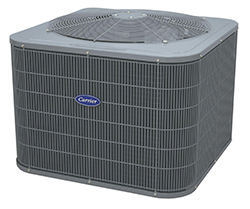 A condenser is the outdoor unit to the system that works together with the compressor. In the cooling process, the compressor pressurizes refrigerant into a hot liquid which cools as it passes through the coils. It leaves the condenser as mist, then turns to gas which gets cooled by the evaporator coil and is blown out by the fan into the ducted areas of your home. A condenser is rated in terms of “seasonal energy efficiency” or SEER. On most air conditioning units you’ll see a yellow sticker labeled “Energy Guide” that displays the SEER rating. The ratings range from 8.0 to 23. The higher the SEER rating, the more energy efficient the unit is. If the label isn’t there, an air conditioner’s SEER rating is also listed near the top of the unit’s manufacturer label, where the model and serial number are listed. Look for the beginning digits of the model number. For example, a model number that begins with 13AC means the air conditioner has a SEER rating of 13. What to do when your outdoor unit stops working: The most common reason why your unit stops working are compressor and coil failures. Both are extremely expensive to repair. Compressor failure is, by far, the most expensive component to repair. The compressor is the engine or heart of the system. The actual cost of the replacement compressor and the labor to install will often exceed the cost of a brand new air conditioning unit on most residential units.
7
Fan motors and capacitor issues are other causes of condenser unit failures.
A condenser is the outdoor unit to the system that works together with the compressor. In the cooling process, the compressor pressurizes refrigerant into a hot liquid which cools as it passes through the coils. It leaves the condenser as mist, then turns to gas which gets cooled by the evaporator coil and is blown out by the fan into the ducted areas of your home. A condenser is rated in terms of “seasonal energy efficiency” or SEER. On most air conditioning units you’ll see a yellow sticker labeled “Energy Guide” that displays the SEER rating. The ratings range from 8.0 to 23. The higher the SEER rating, the more energy efficient the unit is. If the label isn’t there, an air conditioner’s SEER rating is also listed near the top of the unit’s manufacturer label, where the model and serial number are listed. Look for the beginning digits of the model number. For example, a model number that begins with 13AC means the air conditioner has a SEER rating of 13. What to do when your outdoor unit stops working: The most common reason why your unit stops working are compressor and coil failures. Both are extremely expensive to repair. Compressor failure is, by far, the most expensive component to repair. The compressor is the engine or heart of the system. The actual cost of the replacement compressor and the labor to install will often exceed the cost of a brand new air conditioning unit on most residential units.
7
Fan motors and capacitor issues are other causes of condenser unit failures.Condensers
 A condenser is the outdoor unit to the system that works together with the compressor. In the cooling process, the compressor pressurizes refrigerant into a hot liquid which cools as it passes through the coils. It leaves the condenser as mist, then turns to gas which gets cooled by the evaporator coil and is blown out by the fan into the ducted areas of your home. A condenser is rated in terms of “seasonal energy efficiency” or SEER. On most air conditioning units you’ll see a yellow sticker labeled “Energy Guide” that displays the SEER rating. The ratings range from 8.0 to 23. The higher the SEER rating, the more energy efficient the unit is. If the label isn’t there, an air conditioner’s SEER rating is also listed near the top of the unit’s manufacturer label, where the model and serial number are listed. Look for the beginning digits of the model number. For example, a model number that begins with 13AC means the air conditioner has a SEER rating of 13. What to do when your outdoor unit stops working: The most common reason why your unit stops working are compressor and coil failures. Both are extremely expensive to repair. Compressor failure is, by far, the most expensive component to repair. The compressor is the engine or heart of the system. The actual cost of the replacement compressor and the labor to install will often exceed the cost of a brand new air conditioning unit on most residential units.
7
Fan motors and capacitor issues are other causes of condenser unit failures.
A condenser is the outdoor unit to the system that works together with the compressor. In the cooling process, the compressor pressurizes refrigerant into a hot liquid which cools as it passes through the coils. It leaves the condenser as mist, then turns to gas which gets cooled by the evaporator coil and is blown out by the fan into the ducted areas of your home. A condenser is rated in terms of “seasonal energy efficiency” or SEER. On most air conditioning units you’ll see a yellow sticker labeled “Energy Guide” that displays the SEER rating. The ratings range from 8.0 to 23. The higher the SEER rating, the more energy efficient the unit is. If the label isn’t there, an air conditioner’s SEER rating is also listed near the top of the unit’s manufacturer label, where the model and serial number are listed. Look for the beginning digits of the model number. For example, a model number that begins with 13AC means the air conditioner has a SEER rating of 13. What to do when your outdoor unit stops working: The most common reason why your unit stops working are compressor and coil failures. Both are extremely expensive to repair. Compressor failure is, by far, the most expensive component to repair. The compressor is the engine or heart of the system. The actual cost of the replacement compressor and the labor to install will often exceed the cost of a brand new air conditioning unit on most residential units.
7
Fan motors and capacitor issues are other causes of condenser unit failures.